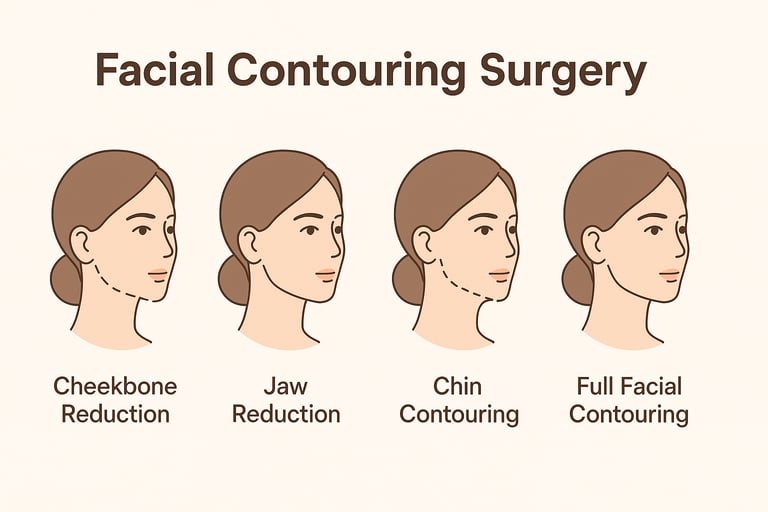Facial Contouring Surgery Types & Aftercare Tips for a Balanced, Refined Look
Discover cheekbone, jaw, and chin contouring options with practical recovery tips to help you achieve natural balance and definition.
HIMSSWIRE
11/22/20253 min read


Facial Contouring Surgery: Finding the Right Balance for Your Features
Facial contouring ("안면 윤곽") isn’t just about making your face smaller. Rather, it focuses on improving overall harmony by smoothing out strong angles and enhancing your natural bone structure.
Whether you want a softer jawline, less prominent cheekbones, or a more defined chin, the right procedure depends on your individual facial shape and aesthetic goals.
Let’s break down the major types of facial contouring surgery, how each works, and what kind of aftercare helps you heal smoothly and successfully.
Cheekbone Reduction (Zygoma Reduction)
When the cheekbones protrude from the front or sides, they can make the face look wide or overly angular. In this case, cheekbone reduction can help soften the overall look and create a more balanced appearance especially from 45-degree and side angles.
Surgeons typically make a precise cut in the bone and rotate it inward. Additionally, they may shave down the outer layer to reduce thickness and smooth the transition between the cheek and the midface.
Surgery time: Approximately 90 minutes
Initial recovery: Swelling typically improves within 1 to 2 weeks
Aftercare tips:
To minimize swelling, try sleeping with your head elevated. Also, avoid chewy or hard foods during the early recovery period. Depending on the materials used, screw removal may be recommended after 6 to 12 months but this varies by clinic and isn’t always necessary.
Jaw Reduction (Mandibular Angle Contouring)
A square jawline can create a strong or masculine impression, particularly when viewed from the side. For those looking to soften this area, jaw reduction smooths out the angle from beneath the ear toward the chin, reshaping the lower face into a more streamlined curve.
In most cases, surgeons trim the outer jawbone and, if needed, reduce the thickness or size of the masseter muscle for a slimmer profile.
Surgery time: Around 1 hour
Initial recovery: Noticeable swelling usually subsides in 2 to 3 weeks
Aftercare tips:
In the first few days, avoid opening your mouth too wide. Maintaining oral hygiene is especially important, as the surgical area lies close to the salivary glands. To enhance results and maintain muscle tone, additional treatments like Botox or ultrasound therapy may also be helpful.
Chin Contouring (Genioplasty / T-Osteotomy)
If your chin feels too short, overly pointed, or slightly off-center, chin contouring can improve facial balance and help frame your jawline more attractively. This surgery often involves a T-shaped cut in the chin bone, which allows the surgeon to move the chin forward, backward, or even adjust its width.
Compared to chin implants, this method offers greater flexibility and precision, especially when correcting asymmetry.
Surgery time: Roughly 1 to 1.5 hours
Initial recovery: Most swelling fades within 2 to 4 weeks
Aftercare tips:
Use an antiseptic mouthwash to reduce the risk of infection. After a few days, warm compresses can ease remaining swelling. For at least a month, try to avoid putting pressure on your chin including leaning on your hand or sleeping face-down.
Full Facial Contouring (Cheekbone + Jaw + Chin)
When you're looking for a more dramatic transformation, such as a V-line face shape or better overall proportions, full facial contouring may be the right choice. This comprehensive approach combines cheekbone reduction, jaw reshaping, and chin contouring in one procedure, offering an opportunity to refine the entire lower face with a unified design.
Before surgery, most surgeons conduct a 3D CT scan to evaluate bone thickness, symmetry, and nerve pathways. Based on this analysis, they develop a personalized surgical plan to achieve natural-looking results without overcorrection.
Surgery time: 3 to 4 hours
Initial recovery: Major swelling improves after about 2 weeks; final results emerge over 3 to 6 months
Aftercare tips:
During the first couple of weeks, stick to soft foods, especially if the incisions were made inside the mouth. Also, avoid putting pressure on your face. This includes sleeping on your side or resting your chin in your hand. Postoperative treatments like laser therapy or lymphatic drainage can speed up recovery and reduce residual swelling.
How to Choose the Right Facial Contouring Approach
Each person’s face tells a different story. That’s why facial contouring shouldn’t follow a one-size-fits-all formula. Instead, it requires a customized approach that considers your bone structure, skin elasticity, and overall facial proportions.
A detailed consultation with an experienced surgeon can help you understand which combination of procedures will best suit your features. You’ll also gain clarity on what to expect at every stage from surgical planning to recovery timelines.
Recovery: The Other Half of a Successful Result
While the surgery itself may take only a few hours, your recovery will shape how everything settles. In fact, how you care for your face afterward plays a huge role in achieving smooth contours and long-lasting symmetry.
By sticking to your aftercare plan, avoiding physical strain, and showing up for follow-up appointments, you give your face the best chance to heal beautifully. Over time, facial contouring can do more than enhance how you look and it can bring out a version of you that feels more confident, composed, and naturally in balance.


